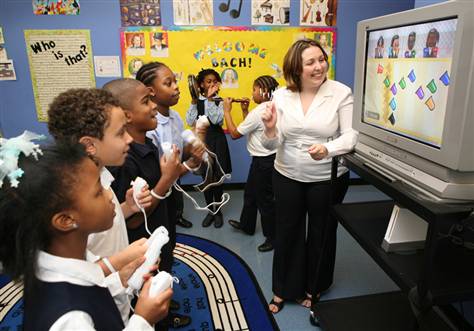 Teachers are the people who must effectively blend high-tech tools into their instruction, but relatively few of them have much say over what classroom technology is purchased.
Teachers are the people who must effectively blend high-tech tools into their instruction, but relatively few of them have much say over what classroom technology is purchased.
As a result, education technology companies spend a lot of time courting school administrators, because they’re the people most likely to decide what to purchase, according to several leaders who track these trends.
“People who make decisions are not the ones using it,” Cory Reid, of MasteryConnect, said at the Tyton Education Summit 2015 in New York City last week. “Put teachers on the team – include them in the design.”
Administrators who hold the purse often ask to see evidence that a product worked in another school. Testimonials from educators who have used the technology are a high priority for school leaders as they decide what to buy, a panelist said at a presentation the next day. With that in mind, companies would be wise to invest time and money into supporting classroom teachers who are using the technology, one panelist said.
“The amount of help you give to your teachers matters more than any brand,” said Din Heiman, of BrainPop, a company that makes educational videos.
The panel discussions took place at an event hosted by Tyton Partners, a consulting firm. The two-day summit included presentations and panel discussions from leading education technology businesses, educators and industry analysts.
Another perspective on education technology purchasing is offered in this recent blog post by Larry Cuban, an emeritus professor of education at Stanford University. Also, a recent report from Digital Promise and the Education Industry Association reveals common challenges in the technology purchase process.
To prepare for education technology purchases, some school leaders are attending training sessions hosted by the U.S. Department of Education and the Alliance for Excellent Education, a nonprofit advocacy organization. On Monday I spent the morning at one of these Future Ready regional summits, this one in Baltimore, Maryland. It’s part of a series of events in 12 cities across the country.
In opening remarks, Tom Murray of the Alliance for Excellent Education said these meetings “are not about buying.” The goal is to create a vision for education, not what gadgets to purchase, he said, and districts should select tools to fit those goals.
“We need to be focused on solutions, not excuses,” Eric Sheninger, who worked as a principal during a technology transformation, told the educators in Baltimore. And Patrick K. Murphy, superintendent of Arlington Public Schools, was one of several speakers who urged administrators to include teachers in education technology planning.
There is always plenty of blended learning news to share. For an update delivered to your inbox every Tuesday, sign up for my weekly newsletter.
This story was produced by The Hechinger Report, a nonprofit, independent news organization focused on inequality and innovation in education. Read more about blended learning.
